Coronavirus Today: Do we need to cancel Christmas?
Good evening. I’m Karen Kaplan, and it’s Tuesday, Dec. 21. We’ll take a break on Christmas Eve and be back with you next week. Here’s the latest on what’s happening with the coronavirus in California and beyond.
If you’re planning to hop a plane to spend Christmas with faraway loved ones, there are probably three words pinging around in your brain:
Should I cancel?
There are good reasons to consider it. Public health officials have been warning for weeks that holiday gatherings have the potential to fuel a fifth coronavirus wave — and those admonitions began before the Omicron variant burst onto the scene.
Now, after a few short weeks, Omicron is estimated to be responsible for 73% of all coronavirus infections in the United States, according to the Centers for Disease Control and Prevention. Plus, the total number of cases is heading back up toward levels seen during the summer’s Delta surge.
It’s still far from clear whether this run-up in new cases will be followed by a corresponding increase in hospitalizations and deaths. There are hints that it won’t, especially for those who are immunized. President Biden assured fully vaccinated Americans they could proceed with the festivities they’d planned.
“Some Americans are wondering if you can safely celebrate the holidays with family and friends,” Biden said Tuesday. “The answer is, ‘Yes, you can,’ if you and those you are celebrating with are vaccinated.”
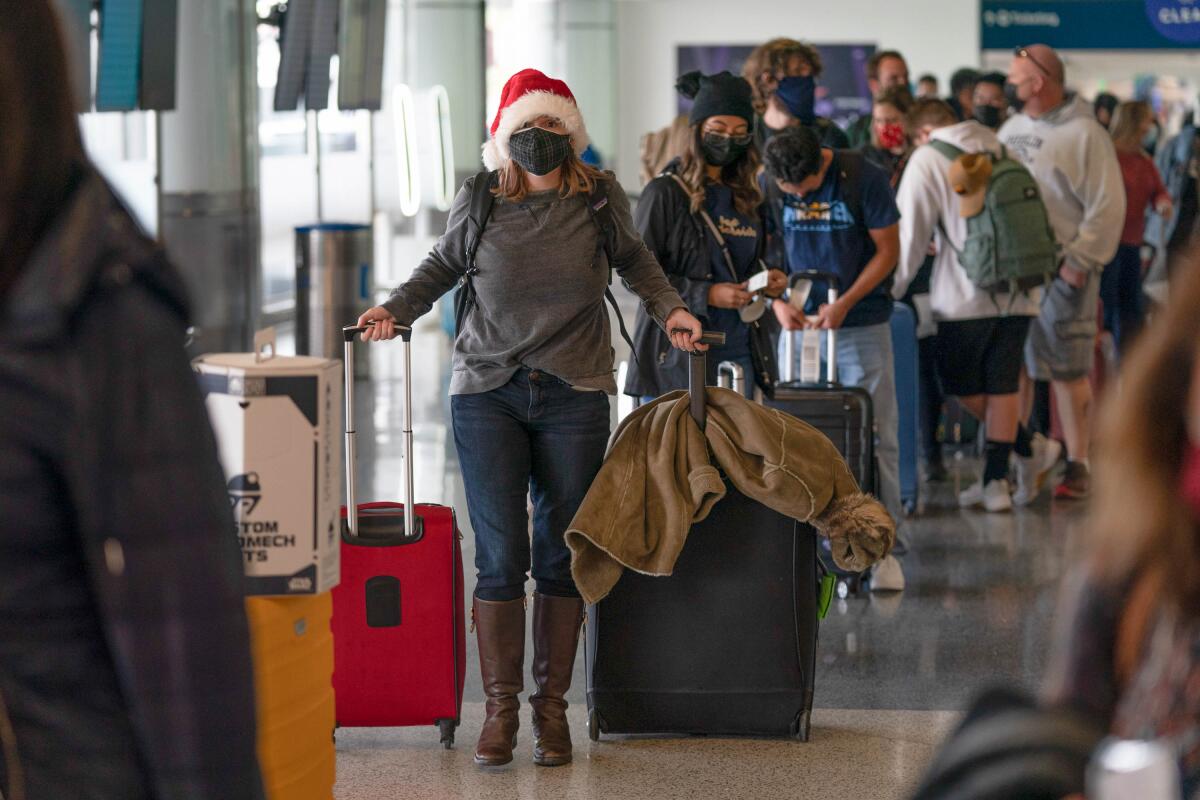
Even so, the prospect of another deadly winter surge is enough to make anyone think twice. There’s no one-size-fits-all answer; your age, vaccination status, health history and risk tolerance all factor in, as do those of your intended hosts.
But there are some rules of thumb that apply to everyone:
• Gatherings are safer if everyone is vaccinated and boosted. If that’s the case, “you should feel comfortable about having a holiday situation where you have dinners and gatherings in your own home with family and friends,” Dr. Anthony Fauci said on ABC late last week.
• Small gatherings pose less risk than large ones, and being outdoors is safer than being indoors. If the point of your trip is to gather around a dining room table, fireplace or TV with your entire extended family, it would be wise to reconsider.
• You can reduce your risk by getting tested in advance. A rapid test will suffice; just take it before you head to the airport and stay home if it says you’re infected. Once you make it to your destination, take another test before heading to a party. “Even if you’re fully vaccinated, getting tested before or after gatherings or parties ... can make a difference in whether you expose someone you love to the virus,” said Dr. Dawn Terashita, associate director of Los Angeles County’s acute communicable disease control program
Perhaps what you really want to know is this: What are the experts planning to do?
Fauci told NBC his three daughters would be flying in from around the country to celebrate Christmas with him, his wife and some friends. Everyone on his guest list is fully vaccinated and boosted, he said.
Dr. Monica Gandhi, an infectious disease expert at UC San Francisco, and her two sons will celebrate the holidays in Boston with her fully vaccinated family. She is comfortable with them wearing regular surgical masks on planes, and only plans to have them take a COVID-19 test if someone comes down with suspicious symptoms. “I’m really not convinced that asymptomatic, vaccinated people are a major source of spread,” she told my colleague Maria L. La Ganga.
UCLA epidemiologist Shira Shafir will spend the holidays at home with her husband and 3-year-old son, who is too young to get vaccinated. If they spend time with others, it will mainly be via Zoom. Because of Omicron, she said, it’s critical to continue wearing masks and maintaining social distance — even for people like herself and her husband who are vaccinated and boosted.
Barbara Ferrer, director of the L.A. County Department of Public Health, canceled her Three Kings Day party for the second year in a row. Instead, she’ll serve Christmas Eve dinner outdoors to a small group of guests who will have to take COVID-19 tests first.
“We’ve all got to invest in taking these safety precautions,” Ferrer said. “It doesn’t work if lots of people just sort of say, ‘I’m done. I can’t do this anymore. I’m not going to do anything.’”
By the numbers
California cases and deaths as of 5:55 p.m. Tuesday:

Track California’s coronavirus spread and vaccination efforts — including the latest numbers and how they break down — with our graphics.
Safety vs. surveillance
Back in 2019, very few of us would have relished the idea of some centralized authority knowing where we were, and who we were with, at any time of the day.
But in 2020, with a global pandemic underway, the notion had some appeal. Millions of Americans have voluntarily enabled the Exposure Notifications feature on their smartphones. The technology keeps track of other people we’ve been physically close to, and for how long. That way, if someone deemed a “close contact” is diagnosed with COVID-19, we can find out about it much sooner than if we’d had to wait for a human contact tracer to connect all the dots.
Use cases like this have made many people less hostile to technological surveillance. Some might even say they’ve embraced it.
Public health emergencies “can be moments where governments roll out new invasive forms of data collection and it just becomes the new normal,” said Ben Green, a University of Michigan researcher who studies the political impact of government algorithms.
“In moments of crisis, there’s a deeper allowance in terms of public trust and legal authority,” Green added. “There’s less of a sense of pausing for reflection, because there doesn’t feel like there is time when dealing with a global pandemic.”
The surveillance helped, at least in some places, my colleague Victoria Kim reports. She points to South Korea, where authorities took technology that had been intended for “smart cities” — places where cameras and sensors gather data to optimize the efficiency of things like trash collection, package delivery and power usage — and repurposed it for epidemiological use.
In its new form, the panoptic software “allowed contact tracers to target a person’s cellphone location data, credit card usage and movements in a matter of minutes,” Kim explains. “The rapid, meticulous tracking was central to the country’s widely celebrated success at pandemic control: Where the U.S. saw more than 240 COVID-19 deaths for every 100,000 people, South Korea lost just 8.”
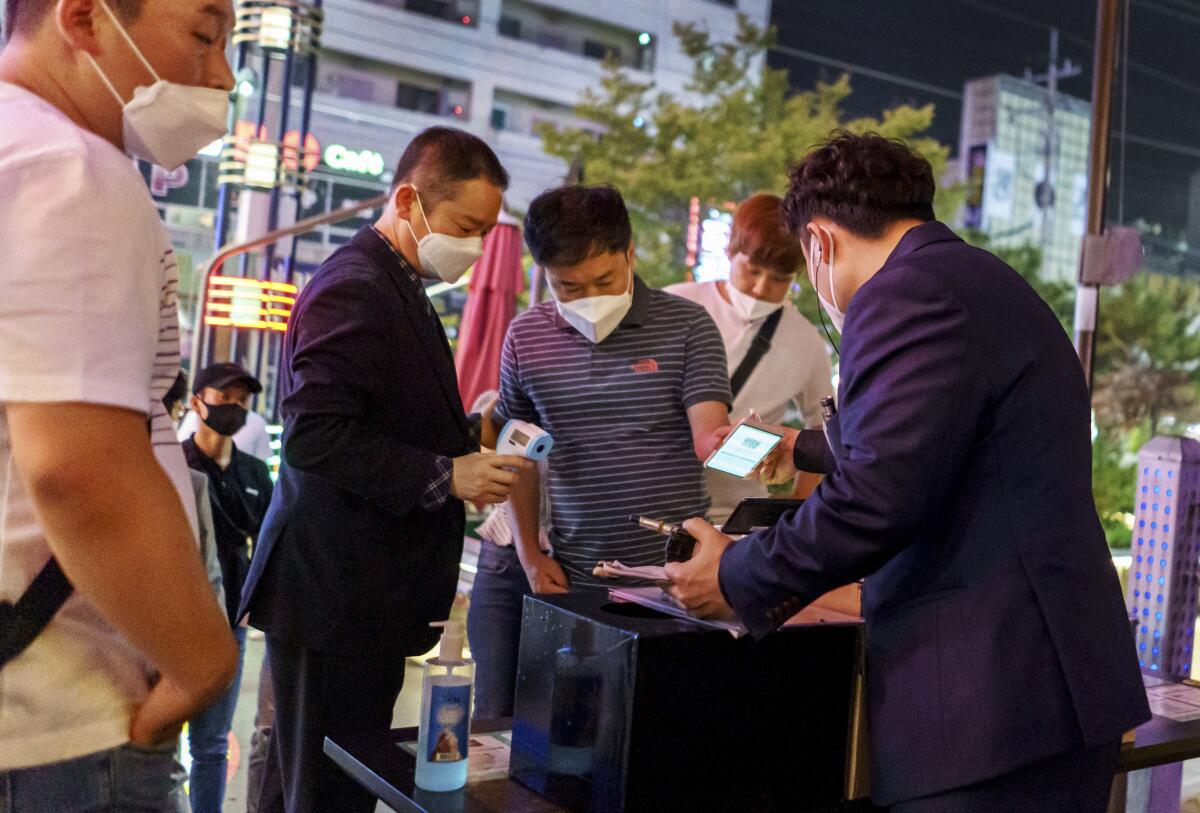
And South Koreans appreciated that payoff. Kim Jae-ho, a professor at Sejong University in Seoul, struck up conversations with cabdrivers when the technology was coming online last year. Rather than being weirded out by the government’s ability to track their whereabouts via their cellphones and credit card transactions, the cabbies said they welcomed it because it alerted them to potential infections.
But even in South Korea, there are limits. When the city of Bucheon said it would use facial recognition software to track people’s movements so human contact tracers wouldn’t have to analyze hours of footage, angry citizens placed calls to City Hall and protested in front of the building.
Now some experts are fretting about a different problem: When the pandemic is over, what will become of all the surveillance that came with it?
Jathan Sadowski, a research fellow in the Emerging Technologies Research Lab at Monash University in Australia, isn’t optimistic that it will go away.
“As history shows, we very rarely go back to the moment before,” he said. “Once new doors have been opened, people are reticent to close them.”
California’s vaccination progress
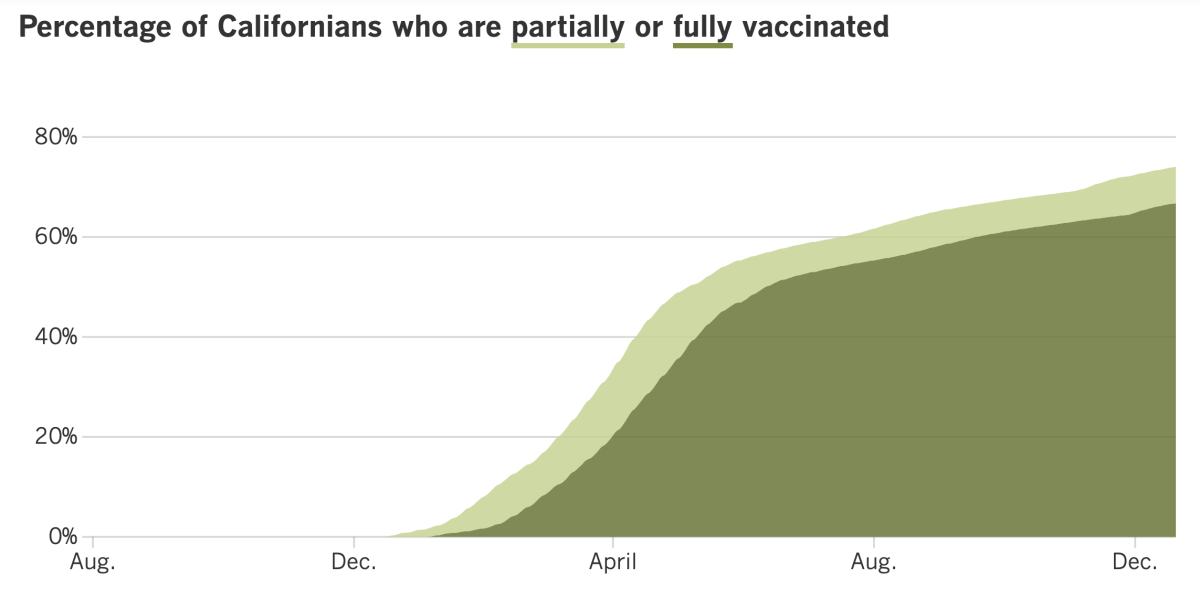
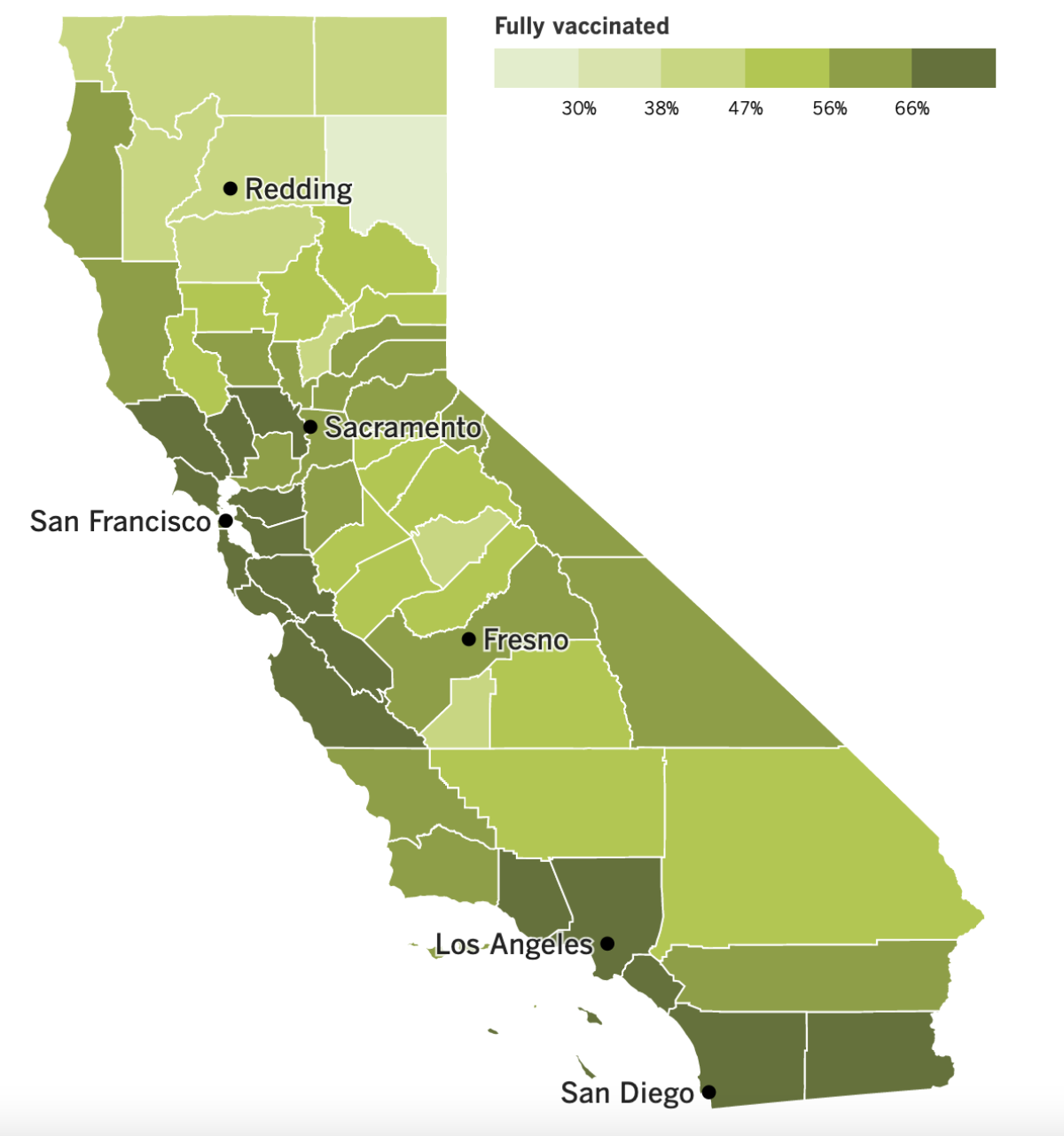
See the latest on California’s vaccination progress with our tracker.
Your support helps us deliver the news that matters most.
In other news ...
President Biden has declared all-out war on Omicron, announcing Tuesday that military medical personnel have been mobilized in preparation for an expected wave of new infections.
The variant is so contagious it’s expected to cause breakthrough infections “potentially in large numbers,” Biden said, though people who are fully vaccinated and boosted are at low risk of becoming seriously ill. That honor belongs to the tens of thousands of unvaccinated Americans. They’re the ones filling up hospitals, from the ER to the ICU.
One thousand doctors, nurses and medics are ready to be deployed to overwhelmed hospitals, the president said. The feds can also send out gloves, masks and ventilators, and help hospitals add beds in short order.
That’s one part of Biden’s new Omicron strategy. He also said the government would buy 500 million at-home COVID-19 test kits and mail them to Americans who wanted them, starting in January.
Half a billion is a big number, but experts outside the administration said it wasn’t nearly big enough.
“It’s a drop in the bucket,” said Dr. Leana Wen, a public health professor at George Washington University. If half of all Americans requested three kits each, the supply would be pretty much exhausted, she said. The goal should be for all Americans to test themselves at least twice a week, she added.
Already, the tests have become nearly impossible to find. My colleagues called a dozen local drugstores and couldn’t find a single one with a test kit on the shelf.
Los Angeles County confirmed 60 new Omicron infections on Monday. That’s more than had been confirmed in the entire state just a couple of days ago.
Some experts fear the Inland Empire and San Joaquin Valley — where vaccination rates are low — are about to get walloped by Omicron. The San Francisco Bay Area, by contrast, should be able to take things in stride since, in most counties, well over 70% of residents are fully vaccinated. L.A. and Orange counties could fall somewhere in between.
Gov. Gavin Newsom is aiming to give the state’s health system a fighting chance with a booster shot mandate for California’s healthcare workers. Likewise, the mayor of San Jose is looking to shore up his city’s protection with a proposal to require booster shots for all municipal employees and for visitors to city-owned facilities.
“We must take decisive action to protect our workforce and our community, and a booster mandate will help,” Mayor Sam Liccardo said. (His plan requires approval from the City Council.)
Students and staff at the University of California who are eligible for a booster shot will be required to have them when they return to campus after winter break, according to a letter sent to chancellors Tuesday by UC President Michael V. Drake. (Incidentally, three UC campuses — those in Irvine, Santa Cruz and San Diego — have delayed the start of in-person classes for the winter quarter by two weeks because of Omicron.) A few days earlier, USC announced it “would likely require booster shots for students” before its spring semester started.
Lab tests conducted by Moderna showed its half-dose third shot increased levels of neutralizing antibodies by a factor of 37. That ought to be enough to offer strong protection against Omicron, the company said.
The preliminary data were revealed in a news release and hadn’t been reviewed by independent scientists. However, tests conducted by the National Institutes of Health found a similar jump in Omicron-fighting antibodies. Pfizer previously announced a booster dose of its vaccine had the comparable effect.
You know who’s already gotten a booster shot? Former President Trump and conservative commentator Bill O’Reilly.
The two disclosed their status Sunday night in Dallas during the final stop of “The History Tour,” a live interview show.
“Did you get the booster?” O’Reilly asked the former president. “Yes,” Trump responded, drawing boos from the crowd in Dallas. “I got it, too,” O’Reilly said, prompting more boos.
Let’s wrap up on a positive note: Of the 99 Omicron cases that have now been confirmed in the county, none has resulted in hospitalization or death.
Your questions answered
Today’s question comes from readers who want to know: How can I minimize my infection risk when I fly for the holidays?
This is for those who’ve weighed the pros and cons and opted to proceed with their travel plans. There’ll be plenty of them — Los Angeles International Airport expects 3.5 million fliers this holiday season.
My colleague Jessica Roy checked in with the experts and offered this advice:
Before your trip: Get vaccinated and, if eligible, get your booster shot. You should also take a COVID-19 test — rapid tests are available at the airport — and stay home if the result is positive. Get your hands on a high-quality mask, like an N95 or KN-95.
At the airport: Wear that high-quality mask as much as you can. Try to keep at least six feet of distance between yourself and travelers from other households. (It’s not going to be possible at all times, but do your best.) While you’re waiting for your boarding group to be called, take a seat in the least-crowded area you can find. And don’t be in a hurry to pack yourself onto a crowded, unventilated jetway.
On your flight: Point the air nozzle above your seat right at yourself and crank it up as high as it will go. The continuous blast of freshly filtered air will help keep others’ germs away. (It will also make you cold, so bring a jacket.) Skip the free soda and pretzels so your mask can remain on at all times. If the flight is too long to go without food or drink, wait until those around you are done and have their masks back on.
After you land: Take another COVID-19 test, then take another a day or two later. This way, if you’ve picked up an infection, you’re more likely to catch it before you spread it to your loved ones.
When you get home: Unvaccinated travelers should quarantine for seven to 10 days and take a COVID-19 test three to five days after their return. If you’re fully vaccinated, you only need to get tested if you develop COVID-19 symptoms.
We want to hear from you. Email us your coronavirus questions, and we’ll do our best to answer them. Wondering if your question’s already been answered? Check out our archive here.
The pandemic in pictures
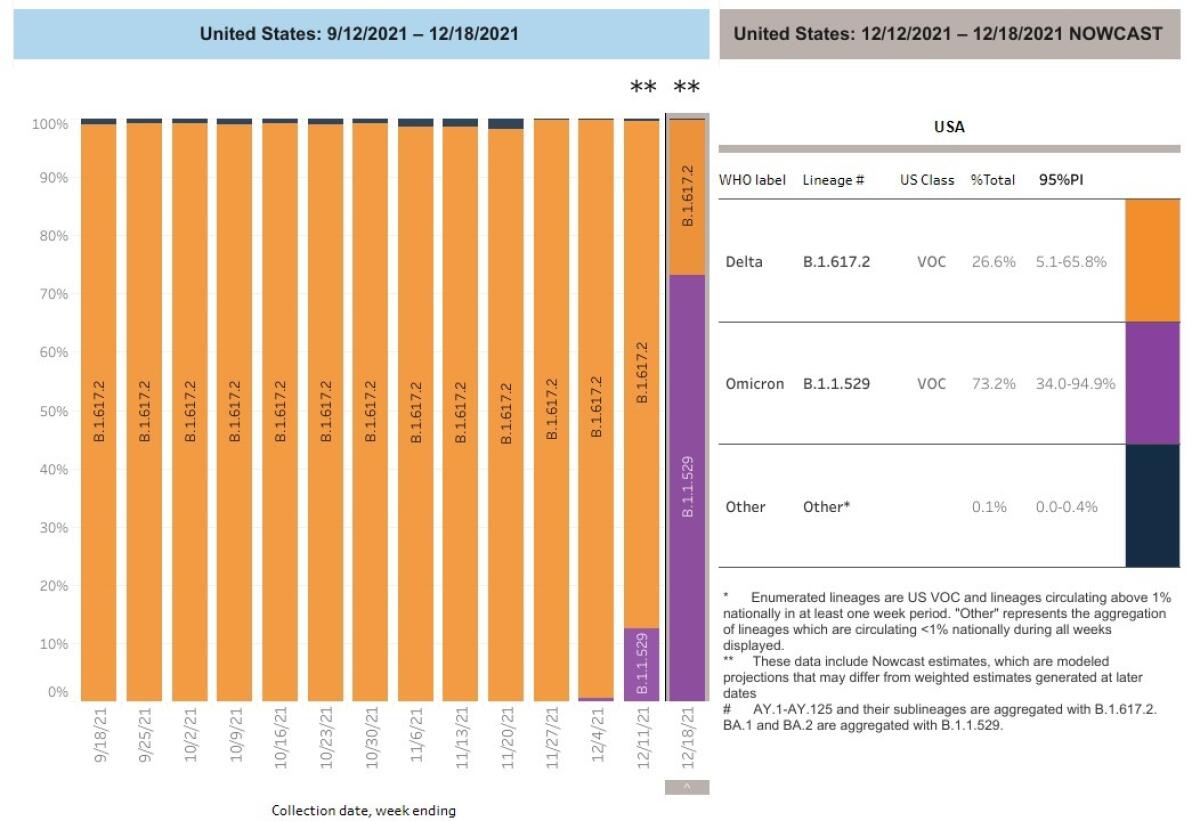
This is a screenshot from the CDC’s COVID Data Tracker. Dr. Rochelle Walensky, the CDC director, tweeted it Monday afternoon.
The bars show the mix of coronavirus variants circulating in the U.S. week by week. Delta is represented in orange, Omicron is purple, and the little bit of navy blue is for everything else.
The fourth bar from the right represents the week that ended Nov. 27, two days after Thanksgiving. During that week, Delta accounted for 99.7% of all coronaviruses in the U.S. and Omicron was estimated to make up just 0.1%.
A week later, Omicron was still flying mostly below the radar, at 0.7% of all coronaviruses. The rest were Delta.
But the week after that, Omicron had shot up to 12.6% of coronaviruses in circulation, and the week after that — the one that ended Saturday — it surged all the way up to 73.2%.
We can say over and over again that the Omicron variant is highly transmissible, but sometimes a picture is worth a thousand words.
Resources
Need a vaccine? Here’s where to go: City of Los Angeles | Los Angeles County | Kern County | Orange County | Riverside County | San Bernardino County | San Diego County | San Luis Obispo County | Santa Barbara County | Ventura County
Practice social distancing using these tips, and wear a mask or two.
Watch for symptoms such as fever, cough, shortness of breath, chills, shaking with chills, muscle pain, headache, sore throat and loss of taste or smell. Here’s what to look for and when.
Need to get a test? Testing in California is free, and you can find a site online or call (833) 422-4255.
Americans are hurting in many ways. We have advice for helping kids cope, resources for people experiencing domestic abuse and a newsletter to help you make ends meet.
We’ve answered hundreds of readers’ questions. Explore them in our archive here.
For our most up-to-date coverage, visit our homepage and our Health section, get our breaking news alerts, and follow us on Twitter and Instagram.




